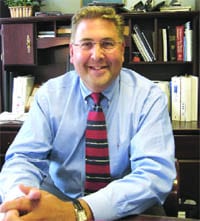Reprogramming the Computer Hypnotherapist Preaches Mind over Matters
Jim Callahan keeps a gold pocket watch in the top drawer of his desk, but he’s never used it. That’s not how he puts his clients into a hypnotic state.
Rather, it’s mostly the sound and modulation of his voice, which he uses to transport people to a place where their brain — which Callahan compared to a computer in many ways — can be, well, reprogrammed.
That’s a very simple yet effective way to describe how hypnotherapy can be used for everything from smoking cessation to weight loss; from gaining relief from irritable bowl syndrome (IBS) to overcoming a fear of public speaking. Those are just a few of the matters Callahan has broached in his 13 years in this business, which he entered enthusiastically after one session of hypnotherapy enabled him to kick a four-pack-a-day smoking habit.
This is a part-time business, said Callahan, who is also a salesperson for a Greenfield-based wholesaler specializing in restaurant supplies, although he believes it has the potential to be much more — if a greater number of people become aware of the many ways hypnosis can be used to improve quality of life, and if there was more open-mindedness about the practice in general.
“A friend who worked with Kaiser Permanente in California once told me that if I went out there and set up shop, I’d make a killing, and he was right,” said Callahan, adding that, while Western Mass. is fairly liberal when it comes to politics, it is still generally conservative with regard to alternative medicine, or at least hypnotherapy. He knows that this equation isn’t likely to change dramatically — not in his lifetime, perhaps — but he is hoping that, through some limited marketing, word-of-mouth referrals, a nearly 80{06cf2b9696b159f874511d23dbc893eb1ac83014175ed30550cfff22781411e5} success rate when it comes to smoking-cessation clients, and some emerging uses of hypnotherapy (like IBS), he can bring more people to his offices on Belmont Avenue in Springfield.
“Hypnotherapists are today where chiropractors were 30 years ago — there are a few around, but not many, and acceptance comes gradually,” said Callahan, who has several competitors and would actually welcome more. “The more that came into chiropractics, the better it was for all of them. It’s the same here; this is a very eclectic treatment, and there’s absolutely no downside to it.”
This month, The Healthcare News takes a look at this unusual venture and how Callahan is continually building his practice by imploring people to put their mind to whatever is troubling them.
Suggestive Material
“Focused concentration.”
This is the state that people are in when they are under hypnosis, said Callahan, adding quickly that the popular notion that people are asleep is incorrect. “They’re awake, they’re alert, they’re able to respond,” he explained. “If someone yelled ‘fire,’ they’d be out the door in two seconds.”
But in this state, the client is also open to suggestion, he continued, which is really what hypnotherapy is all about. And the suggestions range from eating smaller portions at every meal — one of the proven methods for losing weight — to focusing on the content of one’s speech, not the size of the crowd or the prospects for falling on one’s face, which are the main ingredients in most recipes for fear of public speaking.
Hypnotherapy is a field Callahan eagerly sought to enter after his own exposure to the powers of this combination of art and science. A long-time smoker who was being pressed into quitting by his family, he tried a number of tactics but without success. “I could do it for a day, but then I’d just become unglued and go back,” he said.
Approaching desperation, he accepted a friend’s suggestion to visit a Boston-based hypnotherapist. One two-hour session later, he was a non-smoker (more later on how this is accomplished), and remains one today.
While obviously pleased that he had kicked the habit, Callahan came away from his experience with something else — a fascination for hypnotherapy. This was soon channeled into the requisite number of hours in training needed to join the National Guild of Hypnotherapists, and, in 1994, the opening of the Pioneer Valley Hypnosis Center in a small, second-floor office in Springfield’s ‘X’.
On a good week, perhaps 10 or a dozen people will visit the practice, he said, adding quickly that some weeks have no scheduled appointments. He does some limited marketing in hope of gaining a more steady volume of business, but he admits that direct exposure to success stories, not radio ad copy, is needed for many people to seek out his services.
And there are many of them, he said, adding that he’s helped people overcome everything from addiction to nicotine to a fear of spiders — one that actually impacted day-to-day life — to fingernail biting. The full list of problems, or issues, that can be addressed through hypnotherapy, he said, includes eating disorders, bed-wetting, test anxiety, athletic performance, sexual problems, self-esteem, even migraine headaches.
How? Well, this is where Callahan leans heavily on his analogy of a brain to a computer, which makes sense, he said, because the human brain was the first prototype of the computer. With the help of the hypnotherapist, he continued, a client can, in essence, install new software, or alter what is stored in the subconscious part of the brain.
“There are two parts of the brain — the conscious and the subconscious,” Callahan explained. “The conscious part is what I’m talking to right now; there is no information stored there. All the information from your life, everything you’ve learned or experienced, is stored in the subconscious part of your brain.
“If we equate your brain to a computer, the conscious part would be the hardware, the power, the keyboard, the monitor, and so on,” he continued. “The memory, or the software, would be the subconscious part of the brain; you type in what you want the computer to do, it draws from the memory or the information it has, and it makes the computation. That’s how a computer works, and that’s how your brain works.
“If I say to someone, ‘it’s a beautiful day outside,’ the neurons in their brain go from the conscious to the subconscious and draw all the information out on what constitutes a beautiful day,” he went on, “while simultaneously pulling out all the information on what the day has been like up to that point. This is all analyzed, and in a fraction of a second, that person spits out, ‘it sure is.’”
Hypnotherapy works by bypassing the conscious part of the brain, entering the subconscious area, and essentially changing the information stored there. In the case of a smoker, for example, the individual is, in essence, being convinced that he or she is a non-smoker.
And by doing so, that person can overcome the three main hurdles to quitting: addiction to nicotine; the smoking habits that one gets into — lighting up after a meal or with coffee or in the car; and stress, the one that usually prompts people to go back to smoking after they’ve tried to stop.
“When you get stress in your life, one symptom will always be there — your breathing will become very shallow and rapid,” he explained. “When that happens, your brain says, ‘I need some oxygen up here,’ and by the time that gets to the decision-making part of your brain, it gets interpreted as ‘I need a cigarette.’”
Thus, the post-hypnotic suggestion most often used is ‘you could have done the same thing with a deep breath,’ said Callahan, adding that, by using this approach, he has successfully helped roughly three-quarters of those who come to him to quit smoking achieve that goal. That’s better than the national average, and also better than most other strategies.
Intestinal Fortitude
When asked how a psychological treatment, which is how hypnosis is classified, can treat a physiological condition, such as addition to a drug like nicotine, Callahan said he’s asked others in his profession that same question. The simple answer that comes back is ‘mind over matter.’
“Basically, the mind controls the body,” he said, drawing a quick comparison between beating nicotine and walking on hot coals. “Those people are worked into a trance and told that the coals will be cool to the touch. And somehow, it works.”
Indeed, while specific methodologies vary with each problem or issue, hypnotherapy works in essentially the same way for each — having the mind gain more control over the body. Someone with a troubling case of arachnophobia, for example, could be convinced that he or she has no fear of spiders. Someone who chews his nails could be convinced that there is a better way to cope with stress — maybe some of those deep breaths.
And those with IBS could be — could is the operative word here, because hypnotherapy certainly doesn’t work in all cases — convinced to change some of the habits that may or may not contribute to an affliction that has no known cause or established cure.
IBS is a disorder that interferes with the normal functions of the colon. Symptoms include crampy abdominal pain, bloating, constipation, and diarrhea. Those who suffer from it — generally more women than men — have colons that are more sensitive and reactive to things that might not bother other people, such as stress, large meals, certain foods, caffeine, or alcohol. There are medications that can help, but stress reduction and changes in diet are also effective, and hypnotherapy can be applied to both, said Callahan.
“There are hypnotic suggestions that will help their subconscious change the way they eat,” he said, adding that, unlike smokers, IBS sufferers may need six to 12 sessions of hypnotherapy to gain a measure of relief. “It’s fascinating how it works, and it’s great to help a person to be able to control something that they simply don’t want to talk about.”
IBS was recently ranked as the third-most-common reason for missing work on a given day, said Callahan, adding that hypnotherapy can be used to combat other problems that impact the workplace or an individual’s career.
Stress reduction is one of the more common reasons for seeking out a hypnotherapist, for example, he said, adding that sessions for such clients are often devoted to helping transport them to a time and place where there was much less stress. This is done both at Callahan’s office, and in the client’s home or place of business through an audiotape of a given session that can be listened to when the need arises.
“We’ll regress them back to a time in their life when they were in complete control, when success was guaranteed, when they felt terrific,” he explained, adding that he gives each client a cue, such as rubbing their thumb and forefinger together. When they feel stress or anxiety, they are to take a deep breath and use their cue to return to that time and place when there was no anxiety.
Fear of public speaking, meanwhile, is a phobia that can often impact a life or a career. Most individuals can manage to avoid microphones and large audiences, said Callahan, but some can’t — not if they want to climb the ladder.
Rather than get the speaker to picture his or her audience in its collective underwear, as some suggest, Callahan takes another, more effective approach — mainly a sharp focus on the material, not fear over one’s performance.
“Surveys show that people are more afraid of public speaking than they are of dying,” he said. “The problem that most people have is that they’re not concerned with what they’re saying, but rather with their presentation. It’s similar to sports; in golf, and when at bat in baseball, you have to keep your eye on the ball.
“When it comes to public speaking, people are afraid of the presentation — how they’re going to look, how they’re going to sound — and they forget what they’re going to talk about,” he continued. “They’re trying to do two things at once, and the brain can’t do that. They need to keep their eye on the ball, and remain focused on what they’re going to say, not how they’re going to say it. They’ll be at complete peace and calm, no matter how big the audience.”
Voice of Reason
Callahan recalled a recent phone call from an area business executive he helped with her fear of public speaking in the days leading up to an address she was to give to 3,000 people.
The message was short and sweet, he remembered. “She said, ‘I nailed it.’”
From a purely business perspective, Callahan really can’t say the same about his career in hypnotherapy. But he believes there have been many rewards beyond those that are financial in nature.
“I guess I like working with my smoking clients the best,” he explained, with a look of satisfaction. “For each one who succeeds, I know that’s a life saved, or at least prolonged.”
And he didn’t even need a pocket watch.




